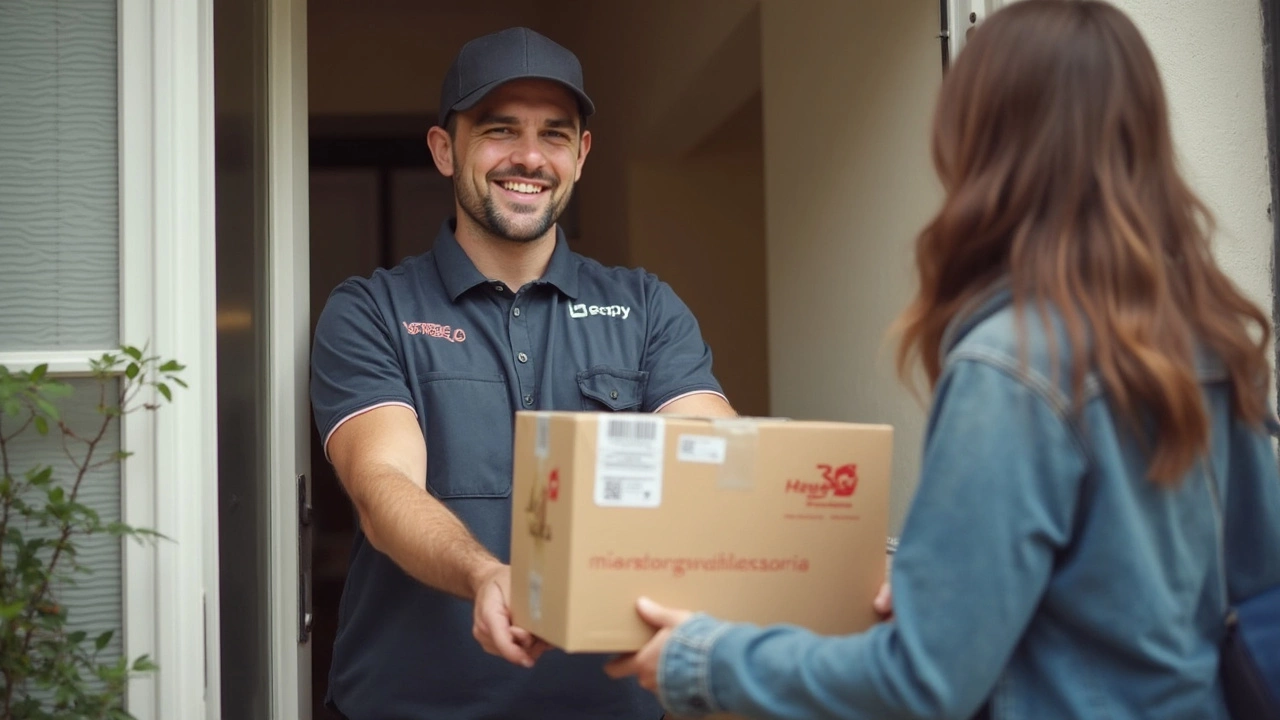Shipping a package overseas shouldn't feel like burning a hole in your wallet. The difference between smart choices and rookie mistakes? Sometimes it’s more than the cost of what you’re sending. With rising international shipping rates, even a tiny misstep—like picking the wrong box or ticking the wrong box on a customs form—can mean paying double what you need to.
The good news? You don't have to pay those crazy high rates if you understand how shipping really works. There are ways to send packages abroad for a fraction of what most folks pay. Whether you’re sending gifts to family or products to customers, every dollar counts. It all starts with knowing what drives the costs, so you can figure out how to dodge the traps and pay just for what you need.
- How Shipping Costs Are Calculated
- Cheapest Carriers and Services for International Shipping
- Smart Packing to Lower Your Shipping Bill
- Hidden Fees and How to Dodge Them
- Ways to Track and Insure on a Budget
How Shipping Costs Are Calculated
The price you pay to send a package overseas isn't just a random guess. Carriers look at a bunch of details before giving you that final number. The biggest ones are package weight, size, where it's going, and how fast you want it there.
First up: cheapest way to ship a package depends a ton on weight. Most carriers round up to the next full pound or kilogram, so that 2.1 kg box is billed as 3 kg. The bigger and heavier the package, the more you’ll pay. Dimensions matter too, especially if your box is large but not that heavy. Carriers use something called "dimensional weight." If your package is bulky, you could be charged like it's heavier than it actually is.
The destination plays a big part. Sending a box from New York to London is cheaper than mailing it to a remote town in Mongolia. Carriers break up the world into zones, and the farther your zone, the more it costs. Expedited or express shipping? That’ll cost you extra, sometimes double or triple regular rates.
Here’s a quick look at what most major shippers use to decide your final price:
- Actual weight (measured in pounds or kilograms)
- Package dimensions (length x width x height)
- Destination country and "zone" distance
- Speed of delivery (standard, expedited, express)
- Type of service (regular mail, courier, economy, etc.)
Curious how this looks in the real world? Check out this sample table showing average 2024 international shipping rates for a small 2 kg package from the US:
| Carrier | Destination | Standard Shipping | Express Shipping |
|---|---|---|---|
| USPS | UK | $55 | $85 |
| FedEx | Australia | $95 | $135 |
| DHL | Germany | $82 | $120 |
| UPS | Japan | $89 | $160 |
Looks pricey, right? That’s why it pays to check rates for different options—and why every little detail about your package matters. Compare, double-check your measurements, and don’t forget to ask if there are slower, cheaper options available.
Cheapest Carriers and Services for International Shipping
Figuring out the cheapest way to ship a package comes down to choosing the right carrier and service. Not all shipping companies are created equal when it comes to price, especially for international deliveries. Here’s what actually works if you want your package to travel far for less.
First off, you have the big names: USPS, FedEx, UPS, and DHL. For small and light items (under 4 lbs), USPS First Class Package International is usually the cheapest among these, especially to places like Canada, the UK, or Australia. Their Priority Mail International Flat Rate boxes save you more if your stuff is heavier, since the price is fixed up to a certain weight and box size.
FedEx International Connect Plus and UPS Worldwide Saver are worth checking if you have a business account or can get a discount via shipping platforms like Pirate Ship or ShipStation. Sometimes, these bulk shipping apps get you prices you just can’t get at the post office desk.
If you’re shipping documents or really light packages, don’t forget about national postal services outside the US. For example, Royal Mail, Canada Post, or Australia Post often cost less for shipments leaving those countries. These services sometimes take longer, but the price tag can be ultra-low for non-urgent shipments.
- Use USPS First-Class Package International for anything light and small.
- Try flat-rate boxes if the stuff is heavy but doesn’t take up much space.
- Compare rates on multi-carrier platforms (like Pirate Ship) before buying postage.
- DHL is popular for speed, but often it’s pricier unless you’re sending big volumes or qualifying for a corporate deal.
One more tip: many countries have local carriers that work with the big names. If the delivery timeframe isn’t tight, these “economy” services can cut your bill in half. For example, APC Postal Logistics and Asendia are used by a ton of online sellers for cheaper European deliveries from the US.

Smart Packing to Lower Your Shipping Bill
Let’s be real—a lot of people waste money on shipping just because they use the wrong box or overdo it with bubble wrap. The weight and size of your package matter way more than you’d think. Carriers charge by either actual weight or something called dimensional weight (that’s basically how big the box is, even if it’s light as a feather). Go oversized, and you’re basically paying for shipping empty air. No thanks.
To save big, first pick a box that’s as snug as you can get for what you’re sending. If you ship a coffee mug in a box meant for sneakers, expect your price to jump. Major carriers like USPS, FedEx, and UPS all use dimensional weight for international shipments. Here’s a quick look at how your box size vs. weight can affect your bottom line:
| Box Size (inches) | Actual Weight (lbs) | Charged Weight | Extra Cost (%) |
|---|---|---|---|
| 8x6x4 | 2 | 2 | 0% |
| 14x14x14 | 2 | 14 | +200% |
Try these quick packing fixes if you want to keep more money in your pocket:
- Use the smallest box that safely fits your item. Every extra inch adds cost.
- Don’t overdo packing materials. A layer of bubble wrap or crumpled paper is plenty for most stuff. Heavy-duty padding only makes sense for fragile or expensive things.
- Look for "flat rate" or "if it fits, it ships" options for small-heavy items. Those can really beat regular pricing for things like books, tools, or tech gadgets.
- Weigh and measure your final, sealed box. Even saving a half-pound can bump you into a cheaper rate tier.
- If you’re shipping a bunch of the same thing all the time, ask your carrier about discount packaging or supplies.
And here’s something a lot of people miss: custom-sized boxes. Some online stores sell made-to-fit boxes so you’re not stuck with oversized packaging from Amazon or the post office. Might take an extra day to get them, but you’ll save a lot over time.
Smart packing is probably the easiest way to knock dollars off the cheapest way to ship a package internationally. Just measure, trim, and keep your packages tight. Your bank account will thank you.
Hidden Fees and How to Dodge Them
Shipping costs aren't just about a sticker price. Carriers are famous for tacking on extra fees that nobody reads until it's too late. If you want the cheapest way to ship a package, you've got to watch out for these sneaky charges.
One big trap is the "fuel surcharge." It’s not included in the main quote from most major carriers like FedEx, DHL, or UPS. These can add anywhere from 10% to 25% on top of the base shipping rate, and the fee changes all the time depending on fuel prices. Don’t just accept the first quote you see. Always look for the section that mentions surcharges—most carriers update them weekly.
Another killer: residential delivery fees. Sending to a home address instead of a business? That can tack on an extra $5 to $7 per package for international shipments. Same goes for "remote area surcharges"—shipping to a town that’s off the grid can easily add $25 or even $50.
Don't forget customs and taxes. When your stuff hits a new country, some customs offices slap VAT, GST, or duties onto your package. Carriers like DHL or UPS often pay these upfront, then bill you a hefty "disbursement fee" (sometimes $10–$20 or more) for the trouble.
Here’s a simple breakdown of common fees you might get hit with:
| Fee Type | Typical Range | Trick to Avoid |
|---|---|---|
| Fuel Surcharge | 10%–25% | Use slower services—these often skip this fee |
| Residential Delivery | $5–$7 | Ship to a business or pickup point |
| Remote Area Surcharge | $25–$50+ | Check carrier's remote area list first |
| Customs Disbursement | $10–$20+ | See if you can prepay taxes or use a postal service |
| Oversize/Dimensional Fee | $10–$100+ | Use snug packaging, measure carefully |
Want to dodge these? Here's what works:
- Compare total costs, not just the shipping label price. Add up the possible extras.
- Use online shipping calculators. USPS, Canada Post, and other national carriers show a closer-to-final price, and they often have fewer surcharges than private couriers.
- Pack small and tight. Carriers use "dimensional weight," so big boxes full of air mean higher fees.
- If sending to a rural or hard-to-reach spot, look at hybrid services—like UPS Mail Innovations or FedEx SmartPost—which use local postal services for the last mile. They cut or skip remote surcharges.
- Whenever possible, ship to a local business address or pickup point to nix the residential delivery fee.
The trick is to dig into the fine print before you pay. Ask for a landed cost (the full door-to-door price with fees included) from every shipping company. Skip the nasty surprises and keep your budget on track.

Ways to Track and Insure on a Budget
Want to know what freaks people out the most about overseas shipping? Losing track of their package or finding out it disappeared into some black hole. Tracking and insurance usually bump up the bill, but skipping them is risky. So, what’s the cheapest way to handle both?
First, tracking doesn’t have to mean shelling out for express shipping. Most big names—like USPS, DHL, FedEx, and UPS—offer free basic tracking on economy services for major international destinations. But here’s the catch: tracking sometimes stops once the package leaves the country or gets handed off to a different carrier abroad. To save cash, stick to entry-level services with built-in basic tracking unless you’re shipping something expensive.
Now, about insurance. Carriers love to sneak in extra insurance fees if you let them do the thinking for you. For low-value stuff, the included coverage (usually about $50 to $100) is enough. But if you’re sending pricier things, check out third-party insurance like Shipsurance or U-PIC. These guys usually beat the carrier’s price by 30-50% and cover lost or damaged items without the nightmare paperwork.
- Always declare the real value on customs forms. Don’t fudge it to save on customs fees—it can void your insurance if something goes wrong.
- If you use an online shipping tool (like Pirate Ship or Easyship), compare the tracking and insurance deals. They sometimes bundle cheaper rates or throw in tracking for free.
- If your item is under $100 in value, there’s a good chance economy shipping gives you both tracking and enough basic coverage without tacking on extra costs.
Check out this quick compare table for real numbers:
| Carrier | Cheapest Service w/ Tracking | Included Insurance | Extra Insurance Cost (per $100) |
|---|---|---|---|
| USPS | First-Class Package Int'l | $50 | $2.05 |
| DHL | eCommerce Packet Plus | $100 | $2.50 |
| FedEx | International Economy | $100 | $1.10 |
| UPS | Standard Worldwide | $100 | $1.25 |
The bottom line: if you’re clever about it, you can have peace of mind without paying premium rates just to track and insure your stuff. Always double-check what’s already included in the basic service, shop around for third-party coverage, and use online tools to hunt for better deals. That’s how you keep your cheapest way to ship a package goal in sight while staying protected.


